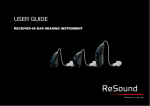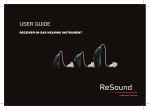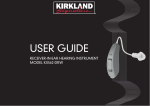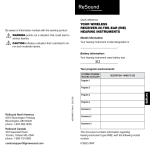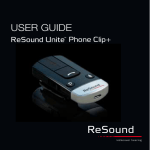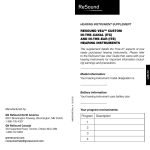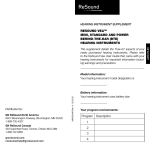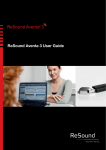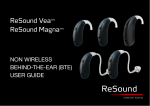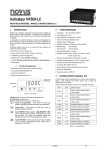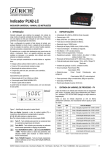Download ReSound AL762-DVIRW User guide
Transcript
USER GUIDE Receiver-In-Ear Hearing Instrument Hearing instrument type designations for models included in this user guide are: SY312, FCC ID: X26SY312 and MRIE, FCC ID: X26MRIE. Please see page 10 for list of models referring to all types. ference will not occur in a particular installation. If this equipment does cause harmful interference to radio or television reception, which can be determined by turning the equipment off and on, the user is encouraged to try to correct the interference by one or more of the following measures: Statement: • Reorient or relocate the receiving antenna. This device complies with Part 15 of the FCC Rules. Operation is subject to the following two conditions: (1) this device may not cause harmful inter ference, and (2) this device must accept any interference received, including interference that may cause undesired operation. Note: This equipment has been tested and found to comply with the limits for a Class B digital device, pursuant to part 15 of the FCC Rules. These limits are designed to provide reasonable protection against harmful interference in a residential installation. This equipment generates, uses and can radiate radio frequency energy and, if not installed and used in accordance with the instructions, may cause harmful interference to radio communications. However, there is no guarantee that inter 2 • Increase the separation between the equipment and receiver. • Connect the equipment into an outlet on a circuit different from the one in which the receiver is connected. • Consult the dealer or an experienced radio/TV technician for help. Changes or modifications can void the user´s authority to operate the equipment 3 Intended use The products are in compliance with the following regulatory requirements: Generic air-conduction hearing instruments are wearable sound-amplifying devices intended to compensate for impaired hearing. The fundamental operating principle of hearing instruments is to receive, amplify, and transfer sound to the ear drum of a hearing impaired person. • In EU: the device conforms to the Essential Requirements according to Annex I of Council Direc tive 93/42/EEC for medical devices (MDD) and essential requirements and other relevant provi sions of Directive 1999/5/EC (R&TTE). The declaration of conformity may be consulted at www.resound.com List of countries: Products without wireless functionality are intended for worldwide sales. Products with wireless functionality are intended for sale in countries within European Economic Area as well as Switzerland. • In US: FCC CFR 47 Part 15, subpart C, section 15.249 • Other identified applicable international regulatory requirements in countries outside EU and US. Please refer to local country requirements for these areas. • Products are categorized as class 2 receiver according to EN 300 440 Specification of restrictions: You are not allowed to operate the equipment within 20 km of the centre of Ny Ålesund, Norway. 4 5 Introduction Congratulations on the purchase of your new hearing instruments. ReSound’s innovative sound technology and design, combined with the customised device programming selected by your hearing care professional, will make hearing a more enjoyable experience. Hearing instruments will enable you to hear sounds that you may not have heard in years because of your hearing loss. Practice and a positive attitude are important in learning to use hearing instruments. Your ReSound instruments have been adjusted according to your individual hearing loss and needs. Some people adjust quickly to wearing hearing instruments in their ears and hearing new sounds; other people may need more time. Please read this manual carefully in order to wholly benefit from the use of your hearing instruments. With proper care, maintenance, and usage, your hearing instruments will aid you in better communi cation for many years. Ask your hearing care professional if you have any questions. Hearing instrument model: Battery size: Left serial number: Receiver tube length: Dome size: Right serial number: ReSound is a registred trade mark of ReSound A/S 6 7 CONTENTS Introduction . . . . . . . . . . . . . . . . . . . . . . . . 6 Description of the hearing instruments . . . 10 Getting started . . . . . . . . . . . . . . . . . . . . 12 On/Off function . . . . . . . . . . . . . . . . . . . . 12 SmartStart . . . . . . . . . . . . . . . . . . . . . . . 12 Inserting/Replacing the battery . . . . . . . . 13 Low battery indicator . . . . . . . . . . . . . . . . 14 Inserting/removing hearing instruments . . 16 Program and Multi-Function buttons . . . . 19 Flight mode . . . . . . . . . . . . . . . . . . . . . . . 25 Telephone use . . . . . . . . . . . . . . . . . . . . 25 8 Listen to radio or TV . . . . . . . . . . . . . . . . PhoneNow . . . . . . . . . . . . . . . . . . . . . . . Telecoil (optional) . . . . . . . . . . . . . . . . . . Direct audio input (optional) . . . . . . . . . . . Connecting/Disconnecting audio boots . Care and maintenance . . . . . . . . . . . . . . Daily maintenance . . . . . . . . . . . . . . . . . . The receiver tube . . . . . . . . . . . . . . . . . . Cleaning the receiver tubes and domes . . Cleaning RIE moulds . . . . . . . . . . . . . . . . Replacing the wax filter (receiver in-the-ear models) . . . . . . . . . . . 27 28 31 32 32 34 35 36 37 37 How to apply domes . . . . . . . . . . . . . . . . General precautions . . . . . . . . . . . . . . . . General warnings . . . . . . . . . . . . . . . . . . Battery warning Information . . . . . . . . . . . Troubleshooting guide . . . . . . . . . . . . . . . Technical data . . . . . . . . . . . . . . . . . . . . . Warranty and repairs . . . . . . . . . . . . . . . . Temperature test, transport and storage information . . . . . . . . . . . . . . 42 44 45 48 50 58 60 61 38 9 RIE Mini-BTE AL960-DR, AL760-DR, AL560-DR, ALT960-DR RIE BTE AL961-DRW, AL761-DRW, AL561-DRW, AL461-DRW ALT961-DRW (Type SY312) AL962-DVIRW, AL762-DVIRW, AL562-DVIRW, ALT962-DVIRW, ALT762-DVIRW (Type MRIE) 1. 2. 3. 4. 5. 6. 7. 8. 9. 10. 10 9 Receiver tube Receiver Open Dome Alera 60 Receiver Tulip Dome Receiver Power Dome RIE mould Sports lock Battery compartment 7 Receiver 1 Push button 8 Volume Control (optional) Alera 61 Alera 62 9, 10 11. NP receiver tube 12. HP receiver tube 13. Left/right indicator 14. Model, and serial number 15. Direct audio input 14 14 13 7 2 3 1 1 8 7 2 4 5 15 13 6 11 8 2 12 11 Getting started On/Off function 1. When the battery door is closed, the hearing instrument turns on, and the default program will be activated. 2. To turn off the hearing instrument, open the battery door. Use your fingernail to pull it open. On Off Tip: Whenever the hearing instruments are not in use, remember to turn them off to avoid unnecessary battery consumption. SmartStart Hearing instruments can be turned on once you have placed them on your ears. If you prefer to turn them on just prior to placing them on your ear, your hearing care professional can activate 12 a function called SmartStart. This function will delay the time in which the hearing instruments turn on by ten seconds after the battery compartment is closed. With SmartStart, a beep will be heard for each second of the delay period. Inserting/Replacing the battery 1. Open the battery door completely by using your fingernail. 2. Remove the used battery, if present. Insert the new battery with the positive side in the correct position. 3. Always use new Zinc-Air batteries that have a minimum remaining shelf life of 1 year. 4. Gently close the battery door. Tip: Remove the batteries to prevent leakage when the hearing instruments are not in use for an extended period of time. 13 Low battery indicator Your hearing care professional can set your hearing instrument to give an acoustical indication when the battery is reaching its end of life. The hearing instrument will reduce amplification and emit a melody if battery power gets too low. This signal will recur every five minutes until the hearing instrument automatically switches off. It is recommended that you keep spare batteries on hand. Low battery indicator (instruments paired with accessories only) Active usage of the ReSound Unite accessories (Remote Control, Phone Clip and TV Streamer) requires more battery power from the hearing instruments than when these are working on their own meaning that battery life is highly dependent on the amount of wireless accessory usage. When the battery in the hearing instrument has depleted to a level at which use of the ReSound 14 Unite TV and Phone Clip cannot be supported, the hearing instrument will play two sets of descending tones. After this, your hearing instrument and ReSound Unite Remote Control will continue to work as usual, but you will not be able to use your ReSound Unite TV and Phone Clip. At some point the battery level will not support the remote control either and you will once again hear the descending tones. The hearing instruments will continue to work as usual. Once a new battery is inserted, full operation of the accessories will resume. Sports lock Sports lock will be applied or adjusted by your hearing care professional. 15 Inserting/Removing hearing instruments Insertion (custom RIE moulds) 1. Hold the RIE mould between your thumb and index finger and position its sound outlet in your ear canal. 2. Slide the RIE mould all the way into your ear with a gentle, twisting movement. 3. Move the RIE mould up and down and gently press to ensure it is positioned correctly in the ear. Opening and closing your mouth can ease insertion. 4. Make sure the hearing instrument is seated behind the ear. By experimenting, an easier method may be discovered. With proper insertion, hearing instruments should fit snugly but comfortably. If hearing instruments cause irritation of the ears, contact your hearing care professional. Never attempt to modify the shape of the hearing instrument, RIE moulds, or tubing yourself. Tip: It may be helpful to pull the top of your ear back with your opposite 16 hand during insertion to open the ear canal. Insertion (domes) 1. Hold the receiver tube where it bends, and gently push the dome into the ear canal. Push the dome far enough into the ear canal so that the receiver tube lies flush with the side of the head. 2. It is important that the tube and the dome fit correctly into your ear. 3. When the dome is placed correctly, you should not be able to see the receiver tube sticking out when facing a mirror. Note: You should never attempt to bend or modify the shape of the receiver tube. Removal (RIE moulds) 17 1. Grasp the removal string and pull the RIE mould outward. 2. Consult your hearing care professional if you have difficulties removing the hearing instrument. Removal (domes) 1. Hold the receiver tube with your thumb and forefinger and pull the tube outward. 2. Consult your hearing care professional if you have difficulties removing the hearing instrument. Program and Multi-Function buttons If you have a hearing aid with a program button or multi-function button, this will allow you to use up to four different listening programs, each of them suit able for certain situations. Your instrument has a fully automatic volume control. Therefore, it should not be necessary to control the volume manually. Program button (Alera 61 only) 18 19 However, in addition to controlling listening pro grams, the multi-function button (Alera 62 only) provides you with the ability to adjust the amplifi cation to your liking. If necessary, your hearing care practitioner can change these settings and fill in the following table to indicate the new settings: The multi-function button is designed to change the volume or listening programs of the hearing instrument, based on different ways it is pressed. Multi-function button (Alera 62 only) 20 Multi-function button action Default setting Short press up Increases volume Short press down Decreases volume Long press up (3 seconds) Changes programs Long press down (3 seconds Activates streaming New setting 21 When using the program or multi-function buttons to switch programs, each press will move the instrument to the next program. For example, if it was in program 1 it will switch to program 2, if it was in program 2 it will switch to program 3 etc. When you close the battery door and switch the instrument on, it will start in program 1. Press the program or multi-function buttons if you want to move to a different listening program. Your hearing care professional can fill out the following table for you. Programme Description of when to use 1 2 3 4 22 23 Flight mode* (Alera 61 and 62 only) When boarding a flight wireless functionality must be deactivated, as it is not allowed to radiate radio signals during flights. For devices with push button: It is possible to disable wireless operation by opening and closing the battery compartment of the hearing instrument while at the same time pressing the push button. When disabled manually, wireless operation may be re-enabled by opening and closing the battery compartment normally, (i.e. without at the same time pressing the push button). For devices without push button: It is possible to disable wireless operation by opening and closing the battery door twice within 10 seconds. Repeat this procedure to enable wireless again. Telephone use If your hearing instruments are fit with a receiver open dome or receiver tulip dome, you can probably use the telephone as you normally would by holding it up to your ear canal opening. If your hearing instruments are fit with a receiver power dome or RIE mould, finding the optimal position for holding a telephone while using a hearing instrument may require practice for some individuals, and one or more of the following suggestions may be helpful. *Instruments paired with accessories only 24 25 1. Hold the telephone as you would normally. 2. Hold the telephone towards the top of the ear (closer to where the microphones are located). 3. If whistling occurs, it may take a brief moment of holding the tele phone in the same position before the hearing instrument adapts and reduces the feedback. 4.Any whistling may also be decreased by holding the telephone slightly away from the ear. 5. Depending on your individual needs, your hearing care professional may activate a pro gramme specifically for telephone use. 26 Listen to radio or TV When listening to the TV or the radio, start out by listening to news commentators since they usually speak clearly, then try other programmes. If you find it difficult to listen to TV or radio, your hearing care professional will be able to give you advice on available accessories to enhance your listening capabilities for TV and radio. Cellular phones Your hearing instrument is designed to comply with the most stringent Standards of International Electromagnetic Compatibility. However, not all cell phones are hearing instrument compatible. The varying degree of disturbance can be due to the nature of your particular cellular phone or of your wireless telephony service provider. If you find it difficult to obtain a good result while using your cellular phone, your hearing care professional will be able to give you advice on available accessories to enhance listening capabilities. 27 PhoneNow The PhoneNow function, allows your hearing instrument to automatically switch to your tele phone programme when a telephone receiver is raised to the ear. When the telephone receiver is removed from the ear, the hearing instrument automatically returns to the previous listening programme. Placement of PhoneNow magnets In order to place PhoneNow magnets properly: 1. Clean the telephone receiver thoroughly. 2. Hold the telephone vertically, in a position similar to when making a telephone call. 3. Place the magnets just below the telephone receiver. If necessary, move the magnet to another position to improve ease of use and comfort while speaking. 28 4. Use only recommended cleaning agent to clean the telephone prior to placing the magnet on the phone. PhoneNow usage Telephones can be used in a normal manner. A short melody will indicate that the PhoneNow feature has automatically switched the hearing instrument to your telephone programme. Initially, you may need to move the telephone receiver slightly to find the best position for reliable PhoneNow activation and good hearing on the telephone. PhoneNow precautions 1. Keep magnets out of reach of pets, children and mentally challenged persons. If a magnet is swallowed, please seek advice from a medical practitioner. 2. The magnet used to strengthen the magnetic field of a telephone receiver may affect 29 functionality of some medical devices or electronic systems. Always keep the magnet or a telephone equipped with the magnet at least 30 cm (12”) away from pacemakers, credit cards and other magnetically sensitive devices. 3.High distortion during dialing or phoning may mean that the magnet is not in the optimal position relative to the telephone receiver. To avoid the issue, please move the magnet to another place on the telephone receiver. 4. Only use magnets supplied by GN ReSound. 30 Telecoil (optional) If equipped, a telecoil can be activated by your hearing care professional and accessed through one of the additional programmes. A telecoil picks up a telephone’s magnetic signal and con verts it to sound. An optional telephone programme may help to improve speech understanding on the telephone. When using a telecoil programme, the receiver of the telephone may need to be held closer to the hearing instrument. The handset of the telephone may need to be moved to slightly different positions in order to find the best reception. Tele-loop systems Many places, such as theatres, houses of worship, and schools are equipped with tele-loop systems. When using a telecoil programme with tele-loop systems, sound is picked up directly and may improve speech understanding. If there is no sound from the hearing instruments in a tele-loop system and with a telecoil programme activated, the tele-loop system may not be turned on or is not operating correctly. If a facility is not equipped with a tele-loop system, sitting as close as possible to the front may be helpful. 31 Direct audio input (optional) Use of direct audio input (DAI), which enables a direct connection of the hearing instruments to items such as television, radio, and remote microphones, may increase speech understanding for some individuals. The sound source is connected to the hearing instruments by a cable or a wireless FM system to the audio boot. This accessory connects to the bottom of the hear ing instruments, and once properly clicked into place, the hearing instruments switch to DAI automatically. Connecting/Disconnecting audio boots 1 Connecting audio boots 1. Align the tip of the audio boot with the groove just above the battery compartment and below the model number. 32 2. Once in place, move the boot in the direction of the battery compartment. 2 3. Gently click the audio boot onto the hearing instrument. Disconnecting audio boots 4. Press and hold the button on the front side of the audio boot. 3 4 5 5. Gently remove the audio boot from the hearing instrument. 33 Care and maintenance Proper handling Your hearing instrument is protected by a layer of protective, hydrophobic nanocoat material. However, please follow the following instructions to further prolong the durability of your hearing instruments. 1. Never immerse hearing instruments in water or other liquids, as liquids may cause permanent damage to the hearing instruments. 2. Avoid rough handling of hearing instruments or dropping them on hard surfaces or floors. 3. Do not leave hearing instruments in or near direct heat or sunlight, as excessive heat can cause damage or deform the casing. 4. Hair spray, make-up, etc. may damage hearing instruments, and these should be removed prior to the application of cosmetics. Daily maintenance It is important to keep your hearing instrument clean and dry. On a daily basis, clean the hearing instruments using a soft cloth or tissue. 34 35 The receiver tube The receiver tube comes in two different power levels: NP HP NP (Normal Power) and HP (High Power). Depending on your hearing loss you have either been fitted with the NP or the HP receiver type. Please go to page 10 to see your selected type. The receiver tube contains the wiring to the receiver which delivers the sound to the ear canal. It is important that the receiver tube and the receiver dome/RIE mold fits correctly in your ear. If the receiver tube or the receiver dome/RIE mould irritates your ear in any way and prevents you from wearing your hearing instrument, please contact your hearing care professional. You should never attempt to modify the shape of the receiver tube yourself. The receiver tube and the receiver dome/RIE mould should be cleaned regularly. Please see instructions in the next section. 36 Cleaning the receiver tubes and domes The receiver tube and the receiver dome should be cleaned regularly. Use a damp cloth to clean the receiver tube and receiver dome on the outside. Do not use water when you are cleaning the receiver tubes or the receiver domes. Please see instruction on page 30 or 31 for how to change the wax guard filter. Cleaning RIE moulds 1. Separate the mould from the receiver tube. 2. Clean the RIE mould using a mild soap, and rinse with lukewarm water. 3. After cleaning, dry RIE moulds thoroughly and remove any residual water and debris from the tubing utilising an air bulb and wire loop. 37 5. Insert the old waxguard into the center of the HF3 wheel. Changing wax guard for NP receiver tube 6. Dispose of the old waxguard by drawing the wand to the narrow end of the center disposal area. 1 2 3 4 5 6 7 8 9 10 1. Clean any debris from the old waxguard. 2. Insert the wand into the old waxguard. 7. Insert the empty wand into a new waxguard on the HF3 wheel. 8. Pull the new waxguard attached to the wand away from the HF3 wheel. 9. Insert the wand into the receiver tube/mould. 10. Twist the wand to release the new waxguard onto the receiver tube/mould. 3. Twist the wand with the waxguard in a clockwise direction to ensure it is attached to the wand. 4. Pull the wand and waxguard away from the tube/mould. 38 39 Changing wax guard for HP receiver tube Power Dome: Please contact your hearing care professional to have the wax guard in the power dome exchanged for you. Changing wax guard for HP receiver tube RIE Mould: 1 40 2 3 4 5 6 7 8 9 10 41 How to apply domes It is recommended that your hearing care professional change domes, as incorrect dome re placement could result in injury. ReSound tulip domes Tulip domes are mounted in a similar manner to standard domes, but a few extra steps are required. Tulip domes consist of two “petals”. It is important to note that the largest petal is the outermost petal. To ensure this: ReSound standard domes 1. Push the new dome over the receiver. 1. Push the largest petal away from the receiver tube using a finger. This bends the petal forward. 2. Make sure that the new dome is is properly and securely mounted. 42 1 2 2. Then push the largest “petal” back, and it will be placed on top of the smaller petal. 43 General precautions 1. Do not leave hearing instruments in the sun, near an open fire, or in a hot, parked car. 2. Do not wear hearing instruments while showering, swimming, in heavy rain, or in a moist atmosphere such as a steam bath or sauna. 3.Should the hearing instrument become moist, remove the battery and place the hearing instrument in a closed container with a drying agent. Your hearing care professional can provide options for drying containers or kits. 4. Remove the hearing instruments when applying items such as cosmetics, perfume, aftershave, hair spray, and suntan lotion. 5. When wireless function is activated, the device uses low-powered digitally coded transmissions in order to communicate with other wireless devices. Although unlikely, nearby electronic devices may be affected. In that case, move the hearing instrument away from the affected electronic device. 44 6. When using wireless functionality and the devices are affected by electromagnetic interference, move away from the source. General warnings 1. Consult a hearing care professional if you discover a foreign object in your ear canal, if you experience skin irritation, or if excessive ear wax accumulates with the use of the hearing instrument. 2. Different types of radiation, from e.g. NMR, MRI, or CT scanners, may damage hearing instruments. It is recommended not to wear hearing instruments during these or other similar procedures. Other types of radiation, such as burglar alarms, room surveillance systems, radio equipment, mobile telephones, contain less energy and will not damage hearing instruments. However, they have the potential to momentarily affect the sound quality or temporarily create strange sounds from hearing instruments. 45 3. Do not wear hearing instruments in mines, oil fields, or other explosive areas unless those areas are certified for hearing instrument use. 9. Turn off your wireless functionality by using the flight mode in areas where radio frequency emission is prohibited. 4. Do not allow others to use your hearing instruments. This may cause damage to the hearing instruments or to the hearing of the other individual. 10. Do only connect ReSound hearing instruments to ReSound accessories intended and qualified to be used with ReSound hearing instruments. 5. Due to a choking hazard, hearing instrument usage by children or mentally challenged individuals should be supervised at all times. 11. For use of wireless functionality do only use ReSound Unite accessories. For further guidance please refer to the user guide of the relevant ReSound Unite accessory. 6.Hearing instruments should be used only as prescribed by your hearing care professional. Incorrect use may result in hearing loss. 7. Be careful when boarding flights to deactivate the wireless functionality. 8. Keep magnets out of reach of pets, children and mentally challenged persons. If a magnet is swallowed, please seek advice from a medical practitioner. 46 47 Battery warning information Batteries, although very small, contain dangerous substances, and should be disposed of care fully. This is for the safety of you and the environment. Please note: 1. DO NOT attempt to recharge standard zinc air batteries. They may leak or explode. 2. DO NOT attempt to dispose of batteries by burning them. 3. DO NOT place batteries in your mouth. Consult a physician immediately if a battery has been swallowed, as they can be harmful to your health. 4. Keep batteries away from pets, children and mentallly challenged persons. 48 49 Troubleshooting Guide SYMPTOM No sound 50 CAUSE • • • • • • • • • • Not turned on Dead battery Battery door will not close Blocked RIE mould or tube Blocked wax filter POSSIBLE REMEDY Turn on by closing the battery door Replace battery Insert battery properly Clean RIE mould or tube Replace wax filter or consult your hearing care professional 51 Troubleshooting Guide SYMPTOM Not loud enough 52 CAUSE POSSIBLE REMEDY • • • • • • • • • • Incorrect RIE mould placement Blocked RIE mould or dome Change in hearing sensitivity Excessive ear wax Volume set too low Reinsert RIE mould Clean RIE mould, replace dome, replace filter Consult your hearing care professional Consult your hearing care professional Consult your hearing care professional 53 Troubleshooting Guide SYMPTOM Excessive whistling / feedback 54 CAUSE POSSIBLE REMEDY • • • • • • • • • • • • Incorrect RIE mould placement Incorrect dome placement Excessive ear wax Feedback control may need adjustment RIE mould tubing worn or damaged Hearing instrument settings not optimal Re-insert RIE mould carefully Re-insert dome Consult your hearing care professional Consult your hearing care professional Consult your hearing care professional Consult your hearing care professional 55 Troubleshooting Guide SYMPTOM CAUSE POSSIBLE REMEDY Sound distorted / not clear • • • • • • • • Wireless does not work • Possible Root Cause - Device is in flight mode Weak battery Improper RIE mould or dome fit Hearing instrument damaged Hearing instrument settings not optimal Replace battery Consult your hearing care professional Consult your hearing care professional Consult your hearing care professional For devices with push button: Open and close the battery compartment. For devices without push button: Open and close the battery door twice within 10 seconds (if Root Cause is device in flight mode) If there are any other problems not mentioned in this guide, please contact your hearing care professional. 56 57 Technical Data Hearing Instrument Model AL961-DRW, AL761-DRW, AL561-DRW, AL461-DRW, ALT961-DRW, AL962-DVIRW, AL762-DVIRW, AL562-DVIRW, ALT962-DVIRW, ALT762-DVIRW (NP-Open) AL961-DRW, AL761-DRW, AL561-DRW, AL461-DRW ALT961-DRW, AL962-DVIRW, AL762-DVIRW, AL562-DVIRW, ALT962-DVIRW, ALT762-DVIRW (NP) AL961-DRW, AL761-DRW, AL561-DRW, AL461-DRW, ALT961-DRW, AL962-DVIRW, AL762-DVIRW, AL562-DVIRW, ALT962-DVIRW, ALT762-DVIRW (HP-Open) AL961-DRW, AL761-DRW, AL561-DRW, AL461-DRW, ALT961-DRW, AL962-DVIRW, AL762-DVIRW, AL562-DVIRW, ALT962-DVIRW, ALT762-DVIRW (HP) 58 Technical Data Maximum output (2cc Coupler / IEC 60118-7) 114 dB SPL (typical) Hearing Instrument Model AL960-DR, AL760-DR, AL560-DR, ALT960-DR (NP-Open) AL960-DR, AL760-DR, AL560-DR, ALT960-DR (NP) AL960-DR, AL760-DR, AL560-DR, ALT960-DR (HP-Open) AL960-DR, AL760-DR, AL560-DR, ALT960-DR (HP) Maximum output (2cc Coupler / IEC 60118-7) 114 dB SPL (typical) 114 dB SPL (typical) 117 dB SPL (typical) 117 dB SPL (typical) 114 dB SPL (typical) 117 dB SPL (typical) 117 dB SPL (typical) 59 Warranty and repairs ReSound provides a warranty on hearing instruments in the event of defects in workmanship or materials, as described in applicable warranty documentation. In its service policy, ReSound pledges to secure functionality at least equivalent to the original hearing instrument. As a signatory to the United Nations Global Compact initiative, ReSound is committed to doing this in line with environment-friendly best practices. Hearing instruments therefore, at ReSound’s discretion, may be replaced by new products or products manufactured from new or serviceable used parts, or repaired using new or refurbished replacement parts. The warranty period of hearing instruments is designated on your warranty card, which is provided by your hearing care professional. 60 For hearing instruments that require service, please contact your hearing care professional for assistance. ReSound hearing instruments that malfunction must be repaired by a qualified technician. Do not attempt to open the case of hearing instruments, as this will invalidate the warranty. Temperature test, transport and storage information GN ReSound Hearing Instruments are subjected to various tests in temperature and damp heating cycling between -25 C and +70C according to internal and industry standards. During transport or storage, the temperature should not exceed the limit values of -20C to 60C and relative humidity of 90% RH, non condensing (for limited time). The air pressure between 500 and 1100 hPa is appropriate. 61 Be aware of information marked with the warning symbol WARNING points out a situation that could lead to serious injuries, CAUTION indicates a situation that could lead to minor and moderate injuries” Advice and tips on how to handle your hearing instrument better. Equipment includes RF transmitter Product is a Type B applied part 62 63 United Kingdom GN ReSound Ltd. Kirtlington Business Centre Portway Kirtlington Oxon OX5 3JA Tel.: +44 1869 352 800 Fax: +44 1869 343 466 www.gnresound.co.uk Australia GN ReSound Pty. Ltd. Unit R1 Regents Park Estate 391 Park Road Regents Park NSW 2143 Tel.: (free) 1800 658 955 Fax: +61 2 9743 7472 www.gnresound.com.au Any issues relating to the EU Medical Device Directive 93/42/EEC, or Council Directive 1999/5/EC on Radio Equipment and Telec ommunications terminal equipment should be directed to ReSound A/S New Zealand GN ReSound (NZ) Ltd. 12 Parkway Drive Mairangi Bay Auckland Tel.: (free) 0800 900 126 Fax: (free) 0800 007 695 www.gnresound.co.nz 17332100-GB-11.11 Rev.F Worldwide Headquarters ReSound A/S Lautrupbjerg 7 DK-2750 Ballerup, Denmark Tel.: +45 45 75 11 11 Fax: +45 45 75 11 19 www.resound.com

































